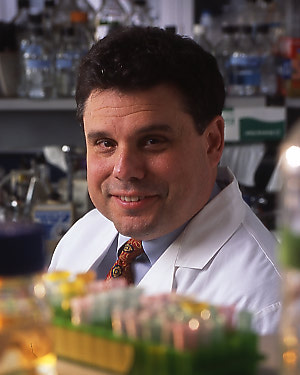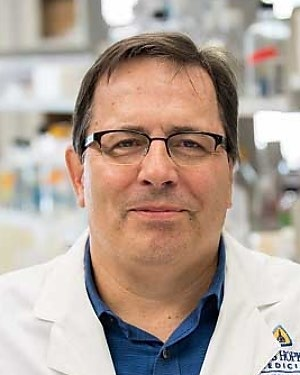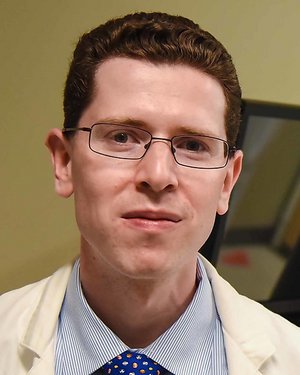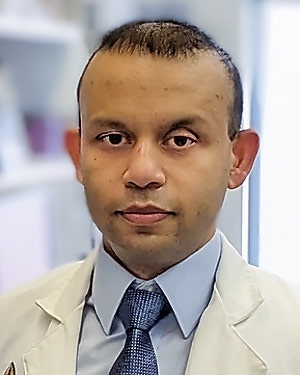-
James M. Berger, PhD

- Director, Institute for Basic Biomedical Sciences, Johns Hopkins University School of Medicine
- Professor of Biophysics and Biophysical Chemistry
-
William G. Nelson, MD PhD DSc

- Director, Sidney Kimmel Comprehensive Cancer Center at Johns Hopkins
- Professor of Oncology
-
Ken Pienta, MD

- Director of Research, The James Buchanan Brady Urological Institute
- Professor of Urology
-
Rana Rais, PhD

- Director, Drug Metabolism and Pharmacokinetics, Johns Hopkins Drug Discovery
- Associate Professor of Neurology
-
Stuart Campbell Ray, MD

- Research Subcouncil Co-Chair of the JHM AI & Data Trust Council
- Professor of Medicine
-
Akira Sawa, MD

- Director, Johns Hopkins Schizophrenia Center
- Professor of Psychiatry and Behavioral Sciences
-
Christopher A. Ross, MD PhD
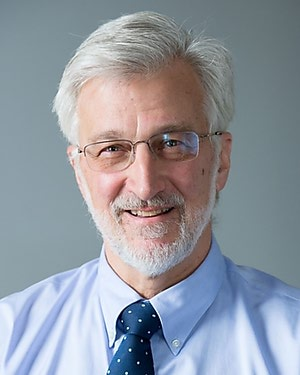
- Director, Division of Neurobiology
- Professor of Psychiatry and Behavioral Sciences
-
Theresa A. Shapiro, MD PhD

- Division Director, Division of Clinical Pharmacology
- Professor of Medicine
-
Wanli Smith, MD PhD

- Director of the Cellular Neurobiology Laboratory
- Professor of Psychiatry and Behavioral Sciences
-
Takashi Tsukamoto, PhD

- Director, Medicinal Chemistry, Johns Hopkins Drug Discovery Program
- Professor of Neurology
Our Program Faculty
The Pharmacology department has a proven track record of producing academic and industrial leaders in biomedical research throughout the country and world. Our gifted faculty are engaged in cutting-edge research spanning many areas including:
- Chemical biology
- Immunology
- Clinical Pharmacology
- Virology
- Cancer
- Neuroscience
- Epigenetics
- Electrochemical sensors
- Drug Metabolism
In This Section:
Primary Faculty

Netz Arroyo, Ph.D., Assistant Professor
Exploiting biology-inspired electrochemical sensing to study the fate of molecules in the body.
Our laboratory focuses on the development of electrochemical biosensors for the continuous detection of small, physiologically-important molecules in vivo. We pursue this by studying the biophysical interactions between receptors and targets, developing signal transduction mechanisms to produce electrical readouts, and by designing and fabricating devices to be directly implanted in the body. Using these we address questions in drug pharmacokinetics and pharmacodynamics, toxicology and metabolism. Our overreaching goals are the development of platforms to achieve metabolism-responsive drug delivery and diagnostic devices for personalized health care.

James C. Barrow, Ph.D., Associate Professor
Drug discovery for disorders of neurodevelopment.
The research group is a laboratory focused on medicinal chemistry and drug discovery, primarily addressing diseases of neurodevelopment such as schizophrenia. The lab is engaged in the design and synthesis of molecules for a given biological target, analysis of in vitro and in vivo results, as well as further refinement through multiple cycles of synthesis and testing. The resulting advanced leads will have good potency and selectivity for the target of interest, and will be used to test biological hypotheses both in vitro and in vivo to determine if modulating the target is indeed a viable therapeutic strategy. By executing on medicinal chemistry programs, we will drive translational science from target and pathway.

Gregory V. Carr, Ph.D., Associate Professor
Preclinical models of neurological and psychiatric disorders.
Psychiatric disorders and related neurodevelopmental disorders result from the complex interaction of multiple genetic and environmental risk factors. Our laboratory uses rodent models to determine how these risk factors modulate neurobiology and behavior. We utilize neurochemical, electrophysiological, and behavioral assays to interrogate the neural systems thought to be impaired in neurodevelopmental disorders. Our ultimate goal is to use this knowledge to inform drug discovery efforts designed to increase and improve the treatment options available for central nervous system disorders.

Bethany Powell Gray, Ph.D., Assistant Professor
Using nucleic acid chemistry and biology to create safer cancer drugs and tunable imaging agents for cancer detection.
Traditionally antibodies have been considered the gold standard of targeting ligands, able to specifically target desired cellular targets with high affinity. Aptamers, small nucleic acid ligands, are targeting ligands with antibody-like affinities and specificities at a fraction of the size. Our lab selects novel aptamers against different cancer targets and utilizes the unique properties of the aptamers to better detect, image and treat tumors. This involves the use of both in vitro biological aptamer selection techniques as well as oligonucleotide synthesis methods. Our ultimate goal is to develop new clinically relevant therapeutic and imaging agents to improve patient outcomes.

Chemical biology and molecular biology; use of small molecules as probes to elucidate mechanisms of signal transduction; angiogenesis and cell proliferation.
Our primary research interest lies at the interface between chemistry, biology and medicine. We employ high-throughput screening to identify modulators of various cellular processes and pathways that have been implicated in human diseases from cancer to autoimmune diseases. Once biologically active compounds are identified, they will serve as both probes of the biological processes of interest and leads for the development of new drugs for treating human diseases.

Caren L. Freel Meyers, Ph.D., Professor
Organic and medicinal chemistry, chemical biology: drug delivery; study of non-mammalian isoprenoid biosynthesis; development of potential therapeutic agents for cancer and infectious disease.
The Freel Meyers lab applies organic synthesis, chemical biology, and enzymology to design novel anti-infective approaches. One research area focuses on developing strategies to selectively inhibit enzymes in the essential bacterial MEP pathway to isoprenoids. In addition, we study the mechanism and function of DXP synthase, the first enzyme in this pathway and critical branch point enzyme in bacterial metabolism, to understand its metabolic roles during infection. We also bring our expertise in small molecule synthesis and prodrug development to a multi-institutional collaboration to invent novel long-acting nanoformulations of clinically-used anti-retrovirals toward a goal to increase adherence and success of life-long HIV treatment.

Bindu D. Paul, Ph.D., Assistant Professor
Redox signaling in aging and neurodegeneration.
Redox regulation plays a central role in signal transduction processes operating in the cell. Disruption of redox signaling is a hallmark of several neurodegenerative diseases such as Alzheimer’s disease, Huntington’s disease, Parkinson’s disease, Amyotrophic Lateral Sclerosis and Ataxias. It is becoming increasingly clear that redox imbalance contributes to disease progression and pathophysiology of these diseases.
My laboratory studies the molecular mechanisms underlying redox homeostasis in the brain with a focus on signaling mediated by gaseous messenger molecules such as hydrogen sulfide (H2S) and nitric oxide (NO). H2S and NO signal via post-translational modifications, on reactive cysteine residues, termed persulfidation/sulfhydration and nitrosylation respectively. Using cell culture, mouse models and patient samples, we have shown that modulating sulfhydration and nitrosylation networks have therapeutic benefits. These studies have yielded important clues that may be harnessed to develop novel therapeutics that delay, halt, reverse or better still, prevent neurodegeneration.

Diane E. Peters, D.V.M., Ph.D., M.S., Assistant Professor
Mouse model characterization, in vivo pharmacology/toxicology, drug discovery, biomarker validation, inflammatory bowel disease.
The Peters lab applies a translational medicine approach to study the pathobiology of inflammatory bowel disease (IBD), with the ultimate goal of developing mechanistically novel IBD therapeutics. Our laboratory uses preclinical rodent colitis models and genetically modified mice to characterize pathways involved in inflammation and pain in IBD, with validation of all findings in human patient samples. We employ molecular pharmacology to interrogate pathways critical to colitis initiation and progression, and work closely with Johns Hopkins Drug Discovery (JHDD) to develop rationally-designed small molecule drugs targeting pathways of interest.
Current efforts in the lab include the development of small molecule glutamate carboxypeptidase (GCPII) inhibitors for use in IBD. GCPII is an enzyme that is highly and specifically upregulated in IBD and we, and others, have shown that GCPII inhibitors protect mice from developing colitis. Expanding on this finding, ongoing activities in our lab include validating GCPII as a clinical biomarker in defined IBD patient populations, exploring the biology of GCPII in the colon, and profiling mechanism(s) of actions of GCPII inhibitors in colitis.

Ronald L. Schnaar, Ph.D., John Jacob Abel Professor and Interim Director
Cellular regulation by glycans in the nervous and immune systems.
Cell-cell recognition occurs when complementary molecules on opposing cell surfaces meet. A receptor on one cell surface binds to its ligand (counter-receptor) on a nearby cell, initiating a cascade of events that regulate cell behaviors ranging from simple adhesion to complex cellular differentiation to cell death. Glycans (glycoproteins, glycolipids, proteoglycans) richly decorate all cell surfaces, and represent the most prominent class of cell surface molecules. Members of this large and varied family are ligands for complementary binding proteins, lectins, on nearby cells. Lectin-carbohydrate interactions mediate cell-cell interactions throughout the body. The study of cell surface glycans, lectins, and their roles in cell physiology are part of the rapidly expanding field of glycobiology. The Schnaar lab studies the functional roles of glycans in immunoregulation and in nerve cell function.

Evgeny Shlevkov, Ph.D., Assistant Professor
The molecular biology of schizophrenia and related neurodevelopmental disorders remains poorly understood. Dysfunctions in several key neurotransmitter systems have been identified, mainly thanks to pharmacological and genetic studies, but how such dysfunctions arise and develop in the first place is unclear. Transcriptomic studies from postmortem brains point toward cellular pathways that may underlie the progression of the disorder. Evgeny’s group is using advanced molecular and cell biology techniques to test novel hypotheses emerging from post-mortem brain studies with the goal of understanding the molecular mechanisms driving the progression of neurodevelopmental disorders. Additionally, and leveraging concepts from systems biology, the group aims at constructing genotype-phenotype-drug response associations with the goal of understanding molecular underpinnings underlying patient-to-patient variability in drug response and therapeutic efficacy. Such an integrative approach, by combining small-molecule screening, cell phenotyping and patient-derived hiPSC technology, has the potential to identify novel druggable cell signaling nodes in schizophrenia and related neurodevelopmental disorders.

James T. Stivers, Ph.D., Professor
Structural and Chemical Biology of Uracil Metabolism and Applications to Cancer Therapy, Innate and Adaptive Immunity.
My lab is interested in how immune cells alter cellular dNTP pools to thwart viral infection. We also study the role of dNTP metabolism in driving mutagenesis, cell senescence and cancer. This area of cell metabolism is rich in new drug targets.

Signal Transduction; protein network; host-pathogen interaction; biomarker identification.
The Zhu lab develops and applies high-throughput technologies to understand the molecular principles at the systems biology level. We have constructed the world-largest human protein array (i.e., HuProt) and are using it for both basic and clinical research. To deal with multipass transmembrane proteins, the Zhu Lab recently invented Virion Display (VirD) technology that provides membrane environment to maintain correct conformation and function of hundreds of human GPCRs. Using these cutting edge technologies, the Zhu Lab has made significant contribution to signaling network construction, epigenetic regulation of transcription, pathogen-host interactions, and biomarker discovery and validation.
Other Training Program Faculty
Craig A. Townsend, Ph.D., Professor
Organic and bioorganic chemistry: biosynthesis of natural products and biomimetic synthesis.

